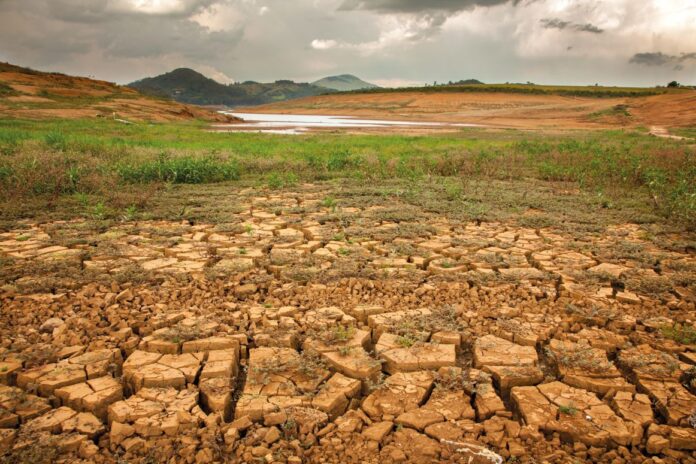The latest United Nations Convention to Combat Desertification (UNCCD) report ‘Drought Hotspots Around the World 2023–2025’, produced jointly by the UNCCD and the US National Drought Mitigation Center, identifies the regions of the world that were most severely affected by droughts in 2023-24, with some continuing into 2025.
By examining the intersection of climatic drivers and underlying vulnerabilities, this report aims to reinforce the continued importance of improving drought monitoring, planning and response capabilities, while providing actionable insights for researchers, policymakers and humanitarian organisations working to address drought resilience.
The report finds that the impacts of climate change, including rising temperatures, altered rainfall patterns and the 2023-24 El Niño event, are the primary drivers of the droughts that have been experienced in recent years, amplifying soil moisture deficits and evaporation, and transforming regional water deficits into systemic disruptions.
Major drought hotspots
The report identifies several regions under acute stress, including: Eastern and Southern Africa, where more than 90 million people are facing acute hunger; Somalia where ~43,000 drought-related deaths were recorded in 2022 and 25% of the country’s population faced crisis-level food insecurity by early 2025; and Zambia, where river flows have dropped to 20% of average flows and the Kariba Dam dropped to just 7% capacity, impacting hydropower supplies resulting in daily blackouts, disrupting healthcare, industry and daily life.
In Turkey, groundwater depletion has resulted in sinkholes, threatening infrastructure and ecosystems. Meanwhile, in Latin America, Amazon watersheds hit historic lows in 2023-24, precipitating mass fish and river dolphin deaths, and compromising transport and access to potable water. The Panama Canal saw daily transits fall from 38 to 24 ships, disrupting global trade and spiking commodity prices. South and Southeast Asia have also been impacted, with drought suppressing the production of staple crops such as rice, coffee and sugar in Thailand and India. Additionally, in India, monsoon variability and groundwater over-extraction is damaging agriculture.
Impacts on transport and global trade
Reduced Panama Canal transit capacity had ripple effects on global shipping and supply chains. Drought has also disrupted river navigation on rivers such as the Amazon and Zambezi, disrupting commerce and livelihoods.
Toll on health and the economy
Drought is raising health concerns, with increased cases of malnutrition, diarrhoea, cholera and dehydration, especially among women, children, the elderly and people with chronic illness. Currently, global annual losses from drought exceed $300bn, and are expected to double by 2035. Studies have found that 77.6% of the Earth’s land has grown permanently drier, with dryland areas swelling by 4.3 million km². The estimated cost of land restoration is projected to be approximately $2.6tn by 2030.
The root causes driving water scarcity are climate change and global warming, with long-term global temperature increases worsening soil evaporation and moisture loss. The 2023-24 El Niño event intensified drought, in Africa, Latin America and Asia in particular.
Unsustainable land and water management
Over-extraction of groundwater, deforestation, irrigation and land degradation have increased the vulnerability of regions facing drought, and many countries still lack proactive national drought strategies and early warning systems.
Report recommendations
The report proposes a multi-level, multi-sectoral response, including:
- Early warning systems and monitoring – deploying real-time drought and impact monitoring incorporating meteorology and socioeconomic data.
- Support systems such as Africa’s sand and dust storm warnings and data from the International Drought Resilience Observatory (IDRO).
- Nature-Based Solutions (NbS) – emphasising watershed restoration, agroforestry, sustainable grazing, reforestation, and groundwater replenishment.
- Infrastructure and water management – expanding desalination, wastewater reuse, aquifer recharge, and resilient water storage systems. Along with decentralised energy systems to reduce dependence on hydropower in drought-prone regions.
- Governance and policy reform – pushing for national drought policies that are proactive, inclusive (including young people, women and Indigenous communities), and cross-sectoral.
- Finance and private sector participation – encouraging incentives and regulation to shift subsidies to sustainable land use, agriculture, and water management.
- Responses to the strategic outcomes of COP16 – including the launch of the World Drought Atlas and IDRO, and the leveraging of AI to improve global drought risk tracking.
Long-term implications
Drylands now cover ~40% of non-Antarctic land – nearly a third larger than India – and account for massive GDP losses, especially in Africa and Asia. The OECD projects drought-related economic costs to have more than doubled since 2000, potentially rising 110% by 2035. Land degradation continues to expand by ~1 million km² per year, accelerating desertification and ecological collapse. However, restoring just one billion hectares could generate up to $1.8tn annually, creating jobs, and reinforcing food, climate and biodiversity resilience.
This UNCCD report marks a turning point – highlighting that drought is no longer a localised hazard, but a systemic global risk, crossing boundaries and systems. It entwines the water-energy-food nexus, undermines economic stability and exacerbates social inequalities. Yet, it also presents a blueprint for transformation through proactive, inclusive governance, science-backed early warning, nature-based and infrastructural adaptation, and scaled financing – including crucial private-sector engagement.
While the COP16 commitments serve as an initial structure for guidance, the real test lies in implementation – the deployment of early warning systems, advances in NbS, the shifting of investment flows, the empowerment of vulnerable communities, the forging of legally binding frameworks, and the mainstreaming of drought resilience across sectors and regions.
This Drought Hotspots report is a clarion call – not just highlighting dramatic drought intensification across continents, but also rigorously framing how to respond. It presents policy foresight and practical solutions: early detection, ecological restoration, governance reform, finance mobilisation and community inclusion. The window for action remains narrow. Global cooperation and resolute action between now and COP17 are vital to halt the march towards irreversible land degradation and safeguard resilience.







